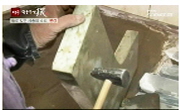국악기의 모습을 결정짓는 요소들은 크기와 형태 그리고 장식일 것이다. 한일병탄이라는 단절된 역사를 가지고 있는 우리나라의 전통음악사에서 국악기의 모습에 관한 연구는 잃어버린 것...
http://chineseinput.net/에서 pinyin(병음)방식으로 중국어를 변환할 수 있습니다.
변환된 중국어를 복사하여 사용하시면 됩니다.
- 中文 을 입력하시려면 zhongwen을 입력하시고 space를누르시면됩니다.
- 北京 을 입력하시려면 beijing을 입력하시고 space를 누르시면 됩니다.
https://www.riss.kr/link?id=A105090385
- 저자
- 발행기관
- 학술지명
- 권호사항
-
발행연도
2017
-
작성언어
Korean
- 주제어
-
등재정보
KCI등재
-
자료형태
학술저널
- 발행기관 URL
-
수록면
261-306(46쪽)
- 제공처
- 소장기관
-
0
상세조회 -
0
다운로드
부가정보
국문 초록 (Abstract)
국악기의 모습을 결정짓는 요소들은 크기와 형태 그리고 장식일 것이다. 한일병탄이라는 단절된 역사를 가지고 있는 우리나라의 전통음악사에서 국악기의 모습에 관한 연구는 잃어버린 것에 대한 되찾기라는 측면에서 특별한 의미를 가질 수 있다. 그럼에도 불구하고 국악기의 장식을 전문적으로 연구한 논문은 아직 없는 듯하다.
본 논문은 조선시대 편종(編鍾)과 편경(編磬)에 사용된 주요 장식에 관한 것이다. 일제시대에 촬영된 악기사진들에 나타나는 용두(龍頭)와 봉두(鳳頭) 그리고 종거(鐘?) 장식과 경거(磬?) 장식을 살펴본 결과 현존하는 편종과 편경에 장식된 것들과 비교해서 상당한 차이가 있음을 알 수 있었다. 동시에 지금까지는 잘 알려지지 않았던 다음과 같은 새로운 사실들도 확인할 수 있었다.
첫째, 조선시대 편종과 편경의 가자(架子)는 조회악용(朝會樂用)과 제례악용(祭禮樂用)으로 구분되는 두 가지 종류였다. 용두와 봉두는 동납연철의 사용유무에 따라 구분되었으며, 사자와 호랑이를 사용한 종거 장식과 물오리와 기러기를 사용한 경거 장식은 어떤 동물을 사용하는가에 따라 구분되었다.
둘째, 지금까지 ‘오리’로만 알려졌던 경거 장식은 정확히 말해서 ‘물오리(청둥오리)’였다. 물오리 장식은 암컷과 수컷으로 보이는 두 종류가 발견되는데, 이것은 동쪽과 서쪽에 마주 세워지는 편경의 경거 장식을 암컷과 수컷으로 다르게 장식하여 음양의 원리를 구현한 것으로 보인다. 이 물오리 장식은 조회악(朝會樂)에 사용되었고 ‘기러기’ 장식은 제례악(祭禮樂)에 사용된 것으로 볼 수 있다.
셋째, 봉두의 모습은 좌우측의 것이 달랐는데 수컷인 봉(鳳)과 암컷인 황(凰)을 조각한 것으로 추정된다. 봉과 황의 좌우위치가 서로 반대로 장식된 편경이 발견되는데 이는 동쪽과 서쪽에 편경을 마주 세웠을 때 수컷(봉)과 암컷(황)이 향하는 방위가 항상 같게 한 것으로 볼 수 있다.
넷째, 『조선아악기사진첩』 및 『이왕가악기』의 편종 사진에 보이는 종거 장식과 에카르트의 『한국음악』에 실린 편종 사진에 보이는 종거 장식은 같은 종류의 동물이며, 이 동물이 바로 사자라는 사실을 알 수 있었다. 전자의 사진은 그 동안 사자 장식이 다소 해괴한 모습의 동물인 것으로 인식시켜왔다. 하지만 후자의 사진은 사자 장식이 조선시대의 미감(美感)으로 조각된 온화하고 소박한 모습임을 보여준다.
다국어 초록 (Multilingual Abstract)
There are little doubt that determining factor of external appearance of the Korean traditional instruments are a size, a shape and an ornament. Study of the features of Korean instruments is extremely significant with regard to regaining the lost sen...
There are little doubt that determining factor of external appearance of the Korean traditional instruments are a size, a shape and an ornament. Study of the features of Korean instruments is extremely significant with regard to regaining the lost sentimentality due to the Japanese colonization. Despite this significance, it seems that not many of close investigation has been conducted into Korean instruments hitherto.
This paper will explore main ornament of p'yonjong 編鍾 and p'yon'gyong 編磬. After searching the figures of a head of a dragon called yongdu 龍頭, and of a head of a chinese phoenix called pongdu 鳳頭, and the chonggo 鐘? ornament and the kyonggo 磬? ornament, it was revealed that the yongdu, pongdu and chonggo, kyonggo from the Choson 朝鮮 Dynasty were clearly different from that of today. Moreover, the unknown facts of the primary ornaments hitherto were able to be noticed.
Firstly, p'yonjong and p'yon'gyong of the Choson Dynasty were used for two kinds of kaja 架子 divided into morning assembly music and ritual music. Whether a copper waxed soft iron was utilized was a deciding factor in dealing with the use of yongdu and pongdu. Furthermore, chonggo ornaments that used lions and tigers, and kyonggo ornaments which used ducks and wild goose were divided in accordance with a type of animal used.
Secondly, the kyonggo ornament which has been known as ducks so far, was, precisely speaking, revealed as a wild duck. P'yon'gyong which deployed two sorts of wild duck ornaments seemingly appears to be both sexes were discovered. This appearance seems to be a representation of the principle of yin 陰 and yang 陽 set facing in the West and the East by differently decorating kyonggo ornament of p'yon'gyong as female and male. This duck ornament was applied for morning assembly music and the wild goose ornament was for ritual music.
Thirdly, pongdu in left and right were not identical in their feature, and this dissimilarity can be assumed to be an engraved male and a female called pong 鳳 and hwang 凰 each. It is observed that the left and right of pong and hwang are reversely decorated. This reserved allocation can be seen that the even direction that pong and hwang head was intended when arranging p'yon'gyong on the East and West.
Fourthly, It can be observed that the chonggo ornaments in the photograph of p'yon'gyong from Choson aakki sajinch'op 『朝鮮雅樂器 寫眞帖』 (The Album of the Choson Court Music) and from Yiwangga akki 『李王家樂器』 (The Album of the Yi Dynasty Instrument) are the same kind of chonggo ornaments from “P'yonjong from Koreanishe Music” written by Andreas Eckardt. Furthermore, with little doubt it is observed that this animal is a lion. The former picture has led a perception that the lion ornaments are rather grotesque, the latter photograph, however, clearly illustrates that the ornament of lion was carved with gentleness and child-like innocence, signifying the aesthetics of the Choson dynasty.
동일학술지(권/호) 다른 논문
-
실물로 전하는 신라의 악기(1)-국내 소장품을 중심으로-
- 한국음악사학회
- 김성혜 ( Kim Seong-hae )
- 2017
- KCI등재
-
한국 전통음악기록물의 보존과 활용 -국악아카이브 소장 기록물을 중심으로-
- 한국음악사학회
- 노예리 ( Noh Yea-ri )
- 2017
- KCI등재
-
- 한국음악사학회
- 배인교 ( Bae Ihn-gyo )
- 2017
- KCI등재
-
- 한국음악사학회
- 윤혜진 ( Yoon Hye-jin )
- 2017
- KCI등재






 KISS
KISS





